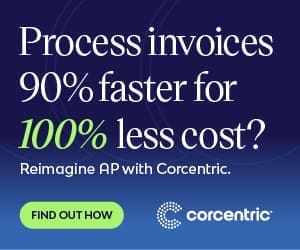The Risk Of Not Implementing An Order-To-Cash Software System
Corcentric

CFO CONCERNS
Adequate financial management is essential for any businesses success, and the C-Suite understands this. Organizations must optimize their order-to-cash (OTC) cycle in order to optimize their financial performance. OTC efficiency is critical for robust top-and-bottom-line growth, cash conversion cycles, customer satisfaction, and compliance with legal requirements. However, performing these processes manually presents significant risk for businesses, and executing them with software can be powerful way to mitigate this risk.
The primary risks of not implementing an order-to-cash software system include the high cost of manual processes, cumbersome audits and investigations, and the strain on internal resources. Manual tasks require significant resources, including time-consuming manual data entries, onerous reconciliation processes, and labor-intensive collections efforts. This can significantly drive up costs and reduce efficiency If business chooses to remain off the software grid, it risks having to perform lengthy and error-prone manual operations.
Error-prone manual operations also limit the accuracy of financial data, thereby creating potential noncompliance with legal regulations, manufacturing defect investigation, and audit claims. Not only can this cause financial implications in the form of fines and penalties, but it can also have an adverse effect on customer satisfaction and public opinion regarding the organization. Furthermore, manual operations have limited visibility and traceability, making it difficult to reproduce and audit data for various purposes and for various stakeholders.
The utilization of order-to-cash (OTC) software systems can go long way in significantly reducing the risk of not implementing one. Automating the OTC process reduces costs and errors as well as improves accuracy and on-time payments to vendors. Additionally, OTC software allows for more thorough audit trails and visibility, making it easier to validate documents, respond to inquiries, and track progress. With real-time visibility, OTC software provides stakeholders with the ability to view financial records, quickly correct any exceptions, and identify any anomalies before they become major problems.
An automated OTC system also provides analytics and insights, allowing businesses to make better financial decisions by helping to uncover trends, document customer orders, generate invoices, and easily consolidate financial data. This allows organizations to develop better strategies and deployment plans that, when implemented, can lead to improved OTC cycle performance.
When deciding to implement software system, CFOs are tasked with finding solution that offers strong security and regulatory compliance standards. secure system requires compliance and data privacy functions to ensure that all customer, vendor, and internal data remain safe.
In sum, the risk for CFOs of not implementing an order-to-cash software system is serious and carries significant risks, including high costs and risks of audit claims and noncompliance. Automated OTC solutions offer vast advantages to organizations looking to improve their financial performance, save resources, and comply with legal regulations with higher accuracy. Although finding the right OTC software can involve considerable investment, the long-term rewards far outweigh any short-term challenges that may arise.

